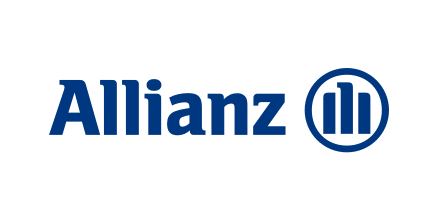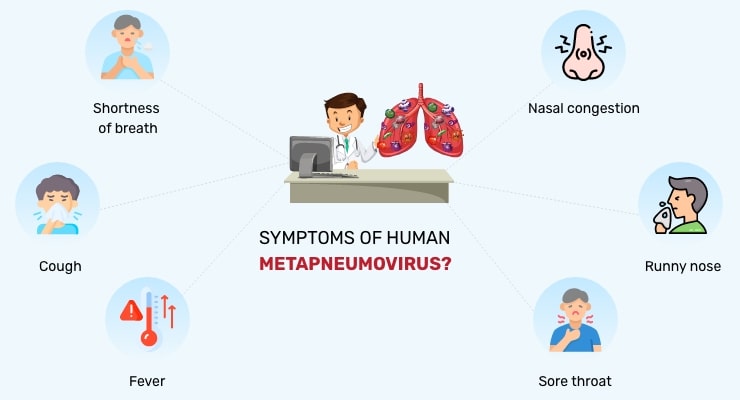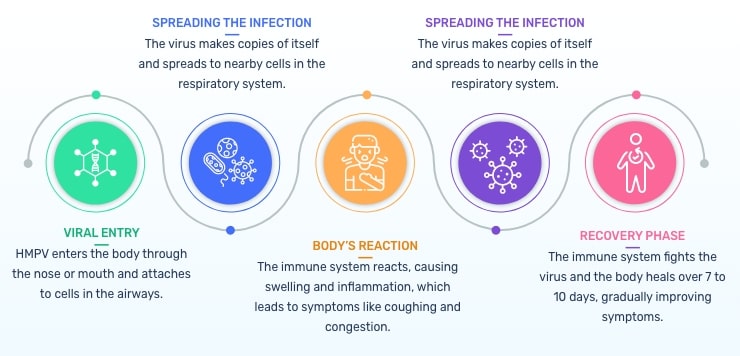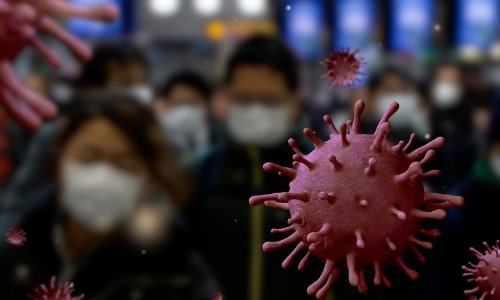800 800 001
Human Metapneumovirus (HMPV): Symptoms, Treatment and Risks
Human metapneumovirus (HMPV), first identified in the Netherlands in 2001, has become a significant contributor to respiratory infections worldwide. Recent data from China indicate that HMPV accounted for 6.2% of positive respiratory illness tests and 5.4% of related hospitalisations in late 2024, ...read more
Health Insurance UAE Plans
















This uptick has led to increased hospital visits, particularly among children under 14, prompting health authorities to improve monitoring efforts. Despite the rise in cases, experts emphasise that HMPV does not pose the same global threat as COVID-19, given its established presence and partial immunity within the population.
What is Human Metapneumovirus (HMPV)?
Human metapneumovirus (HMPV) is a respiratory virus that causes infections similar to the common cold or flu. Discovered in 2001, it belongs to the Pneumoviridae family, which also includes respiratory syncytial virus (RSV).
The virus spreads through respiratory droplets when an infected person coughs or sneezes, as well as through direct contact with contaminated surfaces. Most individuals are exposed to HMPV in early childhood and nearly all children contract the virus by age five.
How Common is Human Metapneumovirus?
Human metapneumovirus (HMPV) is a prevalent respiratory virus affecting individuals worldwide. Recent data from China indicate a significant surge in HMPV cases, particularly among children. Reports suggest that hospitals in northern China are experiencing increased admissions due to HMPV infections, leading to concerns about the virus's rapid spread. (Source - Advertiser.com.au)
In the United States, the Centers for Disease Control and Prevention (CDC) has noted an uptick in HMPV cases since November 2024. However, the CDC emphasises that these numbers remain within pre-pandemic levels and are not currently a cause for alarm. HMPV activity generally rises during the winter flu season, with most children contracting the virus by age five. (Source - New York Post)
Specific data on HMPV prevalence in the UAE is limited. A study conducted in Dubai before the COVID-19 pandemic found that viral respiratory infections accounted for 15% of all healthcare encounters among children. While the study did not provide detailed statistics on HMPV, it highlighted the significant burden of respiratory viruses in the region. (Source - Research Square)
It's important to note that HMPV is not a new virus — it was first identified in 2001 and has been circulating globally since then. So, yes, HMPV is considered as a common respiratory virus, especially in young children, the elderly and individuals with weakened immune systems.
How Deadly is Human Metapneumovirus?
HMPV is generally associated with mild to moderate respiratory illnesses, but it can lead to severe outcomes in vulnerable populations such as young children, the elderly and individuals with weakened immune systems.
It's important to note that while HMPV can be serious, especially for high-risk groups, it is not considered as deadly as some other respiratory viruses. Ongoing surveillance and research are essential to better understand the virus's impact and to develop effective prevention and ment strategies.
What are the Causes of Human Metapneumovirus Infection?
HMPV infections are primarily caused by exposure to the virus through various means.
- Respiratory Droplets: When an infected person coughs or sneezes, tiny droplets containing the virus are released into the air. Inhaling these droplets can lead to infection.
- Direct Contact: Touching an infected person, such as through handshakes or hugs, can transfer the virus, especially if you then touch your face.
- Contaminated Surfaces (Fomites): The virus can survive on surfaces like doorknobs, toys, or countertops. Touching these surfaces and then touching your nose, mouth or eyes can result in infection.
- Close Personal Contact: Living with or caring for someone infected increases the risk of transmission due to prolonged exposure.
- Crowded Environments: Places with large groups, such as schools or daycare centers, facilitate the spread of HMPV due to proximity among individuals.
What Are the Symptoms of Human Metapneumovirus?

- Cough: In HMPV infections, cough is often dry initially but may progress to include mucus production as the infection develops.
- Fever: Fever is a rise in body temperature, usually above 100.4°F (38°C). It is a common early symptom and may vary in severity depending on the individual.
- Nasal Congestion: Nasal congestion occurs due to swelling and inflammation of the nasal passages caused by the virus. It results in difficulty breathing through the nose, often accompanied by pressure or discomfort in the sinuses.
- Shortness of Breath: In severe cases of HMPV, it may suggest that the infection has affected the lower respiratory tract, which might require medical attention.
- Runny Nose: A runny nose involves excessive mucus discharge as the body attempts to flush out the virus. This is a common and often mild symptom seen in respiratory infections like HMPV.
- Sore Throat: A sore throat is caused by irritation or inflammation in the throat due to viral activity. It can lead to discomfort or pain, especially when swallowing or speaking.
- Wheezing: Wheezing is a high-pitched, whistling sound that occurs during breathing, caused by narrowing or blockage of the airways. This symptom is more common in severe cases, particularly in individuals with pre-existing respiratory conditions like asthma.
Which are the High-Risk Groups for Human Metapneumovirus?
HMPV can infect individuals of all ages; however, certain groups are at higher risk for severe illness —
- Young Children: Infants and toddlers, particularly those under the age of five, are more susceptible to serious respiratory complications from HMPV, such as bronchiolitis and pneumonia.
- Older Adults: Individuals aged 65 and older face an increased risk of severe respiratory infections due to age-related weakening of the immune system.
- People with Weakened Immune Systems: Those with compromised immune systems, including organ transplant recipients, cancer patients undergoing chemotherapy or individuals with HIV/AIDS, are at heightened risk for severe HMPV infections.
- Individuals with Chronic Respiratory Conditions: People with underlying respiratory diseases, such as asthma or chronic obstructive pulmonary disease (COPD), may experience exacerbated symptoms and complications if infected with HMPV.
How Long Does the Human Metapneumovirus Last?
Human metapneumovirus (HMPV) infections usually last between 7 to 10 days. Symptoms usually emerge 3 to 6 days after exposure to the virus, with individuals being most contagious during this symptomatic period.
In most cases, the illness is mild and resolves on its own without the need for medical intervention. However, if symptoms persist beyond 10 days or worsen—such as increased difficulty in breathing, high fever or signs of dehydration—it's important to seek medical attention promptly. Early consultation with a healthcare provider is especially important for high-risk groups to prevent potential complications.
How Human Metapneumovirus Affects the Respiratory System?

Human metapneumovirus (HMPV) primarily targets the respiratory system, leading to a range of symptoms from mild cold-like manifestations to severe respiratory conditions.
Here's how HMPV affects the respiratory tract —
- Viral Entry and Attachment: HMPV enters the body through the upper respiratory tract, attaching to the epithelial cells lining the airways. The virus utilises specific proteins to bind to these cells, initiating infection.
- Replication and Spread: Once inside the host cells, HMPV replicates, producing new viral particles. These new viruses infect neighbouring cells, spreading the infection throughout the respiratory tract.
- Immune Response Activation: The presence of the virus triggers the body's immune response, which can lead to inflammation. This inflammatory reaction is responsible for symptoms such as nasal congestion, cough and sore throat.
- Lower Respiratory Tract Involvement: In some cases, the virus descends into the lower respiratory tract, affecting the bronchi and lungs. This can result in more severe conditions like bronchiolitis or pneumonia, characterised by wheezing and difficulty breathing.
- Recovery and Tissue Healing: The infection generally lasts for about 7 to 10 days. During this period, the immune system works to eliminate the virus and the affected respiratory tissues begin to heal.
Do’s and Don’ts of Human Metapneumovirus
HMPV can cause symptoms similar to the common cold. To reduce the risk of infection and prevent its spread, consider the following do's and don'ts:
Do's
- Wash Your Hands Frequently: Use soap and water to clean your hands regularly, especially after coughing, sneezing or touching potentially contaminated surfaces.
- Use Hand Sanitiser: When soap and water are not available, use an alcohol-based hand sanitiser to disinfect your hands.
- Cover Coughs and Sneezes: Always cover your mouth and nose with a tissue or your elbow when coughing or sneezing to prevent the spread of droplets.
- Clean and Disinfect Surfaces: Regularly clean commonly touched objects and surfaces, such as doorknobs, mobile devices and countertops, to eliminate viruses.
- Stay Home When Sick: If you're experiencing symptoms of HMPV, stay at home to avoid spreading the virus to others.
- Avoid Close Contact with Infected Individuals: Keep a safe distance from people showing symptoms of respiratory infections to reduce the risk of catching the virus.
Don'ts
- Don’t keep Close Contact with Infected Individuals: Keep a safe distance from people showing symptoms of respiratory infections to reduce the risk of catching the virus.
- Don't Touch Your Face with Unwashed Hands: Refrain from touching your eyes, nose or mouth without first washing your hands, as this can introduce the virus into your body.
- Do not Share Personal Items: Do not share utensils, towels or other personal items with others, especially if they are sick, to prevent cross-contamination.
- Don't Ignore Symptoms: If you develop symptoms consistent with HMPV, such as cough, fever, or shortness of breath, seek medical advice promptly, especially if you are in a high-risk group.
How is Human Metapneumovirus Detected?
Detecting HMPV involves several diagnostic methods. Healthcare providers may use the following techniques —
- Nucleic Acid Amplification Tests (NAATs): These tests detect the genetic material of HMPV in respiratory samples, such as nasal or throat swabs, through methods like reverse transcription-polymerase chain reaction (RT-PCR). NAATs are highly sensitive and specific, making them a preferred choice for diagnosing HMPV infections.
- Antigen Detection Tests: These tests identify viral proteins (antigens) in respiratory secretions using immunofluorescence or enzyme immunoassay techniques. While they provide quicker results, their sensitivity may be lower compared to NAATs.
- Viral Culture: In this method, respiratory samples are placed in cell cultures to observe viral growth. Although it can confirm the presence of live virus, viral culture is time-consuming and less commonly used for routine HMPV diagnosis.
Treatment and Recovery of Human Metapneumovirus
HMPV infections typically resolve on their own within 2 to 5 days.
Treatment focuses on alleviating symptoms and supporting recovery. Here are some recommended approaches —
Symptom Management
- Over-the-Counter Medications: To reduce fever and relieve pain, consider using acetaminophen or ibuprofen. Decongestants can help ease nasal congestion.
- Hydration: Drink plenty of fluids to stay hydrated, which helps thin mucus and prevent dehydration.
- Rest: Ensure adequate rest to support your immune system in fighting the infection.
Prevention
Currently, there is no vaccine for HMPV. Preventive measures include practicing good hand hygiene, avoiding close contact with infected individuals and disinfecting frequently touched surfaces.
By following these guidelines, most individuals can expect a full recovery from HMPV with appropriate self-care and medical support, when necessary.
Does Your Health Insurance Provide Coverage for HMPV?
In the UAE, health insurance policies are designed to cover a wide range of medical conditions, including respiratory infections like Human Metapneumovirus (HMPV). Currently, HMPV is not classified as a separate category requiring special coverage. Instead, it falls under the general provisions for communicable diseases within standard health insurance plans.
It's important to note that while standard health insurance plans cover common medical conditions, the extent of coverage can vary based on the specific policy and provider. Therefore, it's advisable to review your health insurance policy or consult with your insurance provider to understand the specifics of your coverage, especially concerning communicable diseases like HMPV.
How HMPV Is Different from the Flu or COVID-19?
Human Metapneumovirus (HMPV), Influenza (Flu) and COVID-19 are all respiratory viruses that share certain similarities but also have distinct differences.
|
Feature |
HMPV |
Flu |
COVID-19 |
|---|---|---|---|
|
Causative Agent |
Human Metapneumovirus |
Influenza A and B viruses |
SARS-CoV-2 virus |
|
Symptoms |
Similar to common cold: cough, runny nose, sore throat, fever; can lead to bronchitis or pneumonia in severe cases |
Fever, cough, sore throat, muscle aches, fatigue; can lead to severe complications like pneumonia |
Wide range: fever, cough, shortness of breath, loss of taste or smell; severe cases can lead to acute respiratory distress syndrome |
|
Seasonality |
Peaks in winter and spring |
Peaks in winter |
Can spread year-round; initial outbreaks noted in winter |
|
Severity |
Generally mild; severe illness possible in infants, elderly and immunocompromised individuals |
Can be mild to severe; higher risk of complications in young children, elderly and those with underlying health conditions |
Severity ranges from mild to severe; higher mortality rate compared to HMPV and flu, especially in older adults and those with underlying conditions |
|
Vaccination |
No vaccine currently available |
Annual vaccines available and recommended |
Vaccines available; booster doses recommended to maintain immunity |
|
Treatment |
Supportive care — no specific antiviral treatment |
Antiviral medications available; supportive care |
Antiviral treatments (e.g., remdesivir); supportive care; hospitalization in severe cases |
Disclaimer:
This article is for informational purposes only and does not intend to replace professional medical advice, diagnosis or treatment. Always consult a qualified healthcare provider for any questions or concerns you may have regarding your health or a medical condition. Do not rely solely on the information provided here for medical decisions or treatment plans.
Health Insurance Popular Searches
Medical Insurance | Dubai Health Insurance Cost | Health Insurance for Kids | Health Insurance Plans for Family | Dental Insurance | Individual Health Insurance | Health Insurance Abu Dhabi | Medical Insurance Sharjah | How to check Medical Insurance status with Emirates ID | Best Medical Insurance in UAE | Health Insurance for Parents | Maternity Insurance UAE
More From Health Insurance
- Recent Articles
- Popular Articles







.png)


















